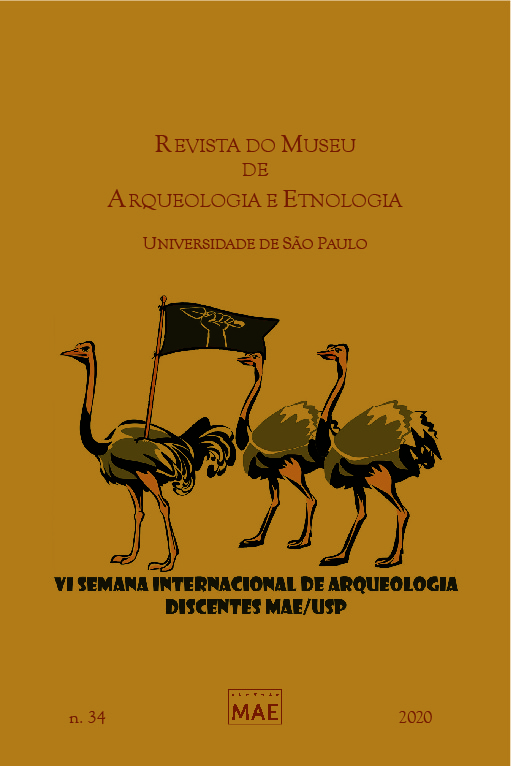Collaborative Archaeology is not the end
DOI:
https://doi.org/10.11606/issn.2448-1750.revmae.2020.163597Keywords:
Collaboration, equality, scientific methodAbstract
More than a century ago, scientific archaeology was caught up in the webs of colonialism. Around the globe, nations extracted cultural resources from distant locales—most often in Indigenous communities—to construct histories, build museums, and garner prestige and power for academics and the institutions they served. In the 1970s, Indigenous activists and their allies began to challenge this model and propose alternatives that empowered local communities to control their own heritage. One of the most important ideas to arrive out of this movement was that of collaborative archaeology, which argues for an equitable sharing of the past between scientists and community members. Collaboration has opened up radical new possibilities for archaeology. However, we have arrived at a key moment where we must consider how collaboration also risks reinscribing colonialist power structures when it is practiced as an end instead of a means. Collaboration in archaeology is not a solution to colonialism, but a tool that communities and scholars can use in the discipline’s search for a postcolonial future.
Downloads
References
Abu el-Haj, N. 2001. Facts on the ground: archaeological practice and territorial self-fashioning in Israeli society. University of Chicago Press, Chicago.
Acabado, S.; Martin, M.; Datar, F. Ifugao archaeology: collaborative and indigenous archaeology in the Northern Philippines. Advances in Archaeological Practice 5: 1-11.
Arnold, B. 1990. The past as propaganda: totalitarian archaeology in nazi Germany. Antiquity 64: 464-478.
Bender, B. 1998. Stonehenge: making space. Berg Press, Oxford.
Bernbeck, R; Pollock, S. 1996. Ayodhya, archaeology, and identity. Current Anthropology 37: 138-142.
Boast, R. 2011. Neocolonial collaboration: museum as contact zone revisted. Museum Anthropology 34: 56-70.
Bray, J.N. et al. 2000. Collaborative inquiry in practice. Sage, Thousand Oaks.
Cipolla, C.N.; Quinn, J.; Levy, J. 2019. Theory in collaborative indigenous archaeology: insights from Mohegan. American Antiquity 84: 127-142.
Colwell-Chanthaphonh, C. (2003). Dismembering/disremembering the Buddhas: renderings on the internet during the Afghan purge of the past. Journal of Social Archaeology, 3(1), 75-98.
Colwell-Chanthaphonh, C., & Ferguson, T. J. (Eds.). (2008). Collaboration in archaeological practice: engaging descendant communities. Rowman Altamira.
Colwell-Chanthaphonh, C. (2010). Living Histories: Native Americans and Southwestern Archaeology. Rowman Altamira.
Colwell, C. (2016). Collaborative archaeologies and descendant communities. Annual Review of Anthropology, 45, 113-127.
Deloria Jr., V. 1969. Custer died for your sins: an Indian Manifesto. Macmillan, New York.
Fluehr-Lobban, C. 2003. Dialogue for ethically conscious practice. In: Fluehr-Lobban, C. (Ed.). Ethics and the profession of anthropology: dialogue for ethically conscious practice. AltaMira Press, Walnut Creek, 225-246.
Fricker, M. 2007. Epistemic injustice: power and the ethics of knowing. Oxford University Press, Oxford.
Funari, P.P.A. 2001. Public archaeology from a Latin American perspective. Public Archaeology 1: 239-243.
Hinsley, C.M. 1996. Digging for identity: reflections on the cultural background of collecting. American Indian Quarterly 20: 180-196.
Jefferson, T. 1787. Notes on the state of Virginia. John Stockdale, Piccadilly.
Kuhn, T.S. 1996. The structure of scientific revolutions. University of Chicago Press, Chicago.
Marshall, Y. 2002. What is community archaeology? World Archaeology 34: 211-219.
McAnany, P.A.; Rowe, S.M. 2015. Re-visiting the field: collaborative archaeology as a paradigm shift. Journal of Field Archaeology 40: 499-507.
McGimsey III, C.R. 1972. Public archaeology.Seminar Press, New York.
Mrozowski, S.A. 2017. Listening and learning: the benefits of collaborative archaeology." SAA Archaeological Record 17: 28-30.
Nicholas, G. 2012. Collaborative, community-based heritage research, and the IPinCH project. SAA Archaeological Record 12: 30-32.
Onciul, B. 2015. Museums, heritage, and indigenous voice: decolonising engagement. Routledge, New York.
Potter, P.B. 1994. Public archaeology in Annapolis: a critical approach to history in Maryland’s “ancient city”. Smithsonian Institution Press, Washington.
Pryor, F. 1989. Look what we've found – a case study in public archaeology. Antiquity 63: 51-61.
Said, E.W. 1978. Orientalism. Vintage Books, New York.
Schmidt, P.R. 2014. Rediscovering community archaeology in Africa and reframing its practice. Journal of Community Archaeology & Heritage 1: 37-55.
Shackel, P.A.; Chambers, E.J. (Eds.). 2004. Places in mind: public archaeology as applied anthropology. Routledge, London.
Silliman, S.W. (Ed.). 2008. Collaborating at the trowel’s edge: teaching and learning in indigenous archaeology. University of Arizona Press, Tucson.
Silverberg, R. 1968. Mound builders of ancient America: the archaeology of a myth. New York Graphic Society, Greenwich.
Smith, L.; Waterton, E. 2009. Heritage, communities, and archaeology. Duckworth, London.
Trigger, B.G. 1984. Alternative archaeologies: nationalist, colonialist, imperialist. Man 19: 355-370.
Welch, J.R., Lepofsky, D.; Washington, M. 2011. Assessing collaboration with the Sliammon first nation in a community-based heritage research and stewardship program. Archaeological Review from Cambridge 26: 171-190.
Wilcox, M. 2010. Marketing conquest and the vanishing indian: an indigenous response to Jared Diamond's Guns, germs, and steel and collapse. Journal of Social Archaeology 10: 92-117.
Wylie, A. 2015. A plurality of pluralisms: collaborative practice in archaeology. In: Padovani, F.; Richardson, A.; Tsou, J.Y. (Eds.). Objectivity in science: new perspectives from science and technology studies, Springer, New York, 189-210.
Wylie, A. 2008. Legacies of collaboration: transformative criticism in archaeology. In: Proceedings of American Anthropological Association Conference, 2008, San Francisco.
Downloads
Published
Issue
Section
License
Copyright (c) 2020 Chip Colwell, Rafael de Almeida Lopes

This work is licensed under a Creative Commons Attribution-NonCommercial-NoDerivatives 4.0 International License.













